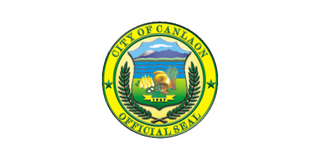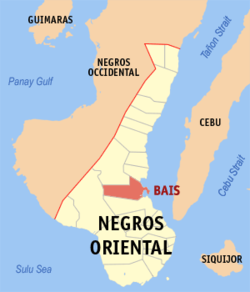
Valencia, officially the Municipality of Valencia, is a 1st class municipality in the province of Negros Oriental, Philippines. According to the 2020 census, it has a population of 38,733 people.

Canlaon, officially the City of Canlaon, is a 4th class component city in the province of Negros Oriental, Philippines. According to the 2020 census, it has a population of 58,822 people.

Tanjay, officially the City of Tanjay, is a 4th class component city in the province of Negros Oriental, Philippines. According to the 2020 census, it has a population of 82,642 people.

Ayungon, officially the Municipality of Ayungon, is a 2nd class municipality in the province of Negros Oriental, Philippines. According to the 2020 census, it has a population of 47,102 people.

Basay, officially the Municipality of Basay, is a 4th class municipality in the province of Negros Oriental, Philippines. According to the 2020 census, it has a population of 28,531 people.

Bindoy, officially the Municipality of Bindoy, is a 3rd class municipality in the province of Negros Oriental, Philippines. According to the 2020 census, it has a population of 40,308 people.

Dauin, officially the Municipality of Dauin is a 4th class municipality in the province of Negros Oriental, Philippines. According to the 2020 census, it has a population of 30,018 people.

Jimalalud, officially the Municipality of Jimalalud, is a 4th class municipality in the province of Negros Oriental, Philippines. According to the 2020 census, it has a population of 32,256 people.

La Libertad, officially the Municipality of La Libertad, is a 3rd class municipality in the province of Negros Oriental, Philippines. According to the 2020 census, it has a population of 41,089 people.

Mabinay, officially the Municipality of Mabinay, is a 1st class municipality in the province of Negros Oriental, Philippines. According to the 2020 census, it has a population of 82,953 people, making it the most-populous municipality in Negros Oriental.

Manjuyod, officially the Municipality of Manjuyod, is a 2nd class municipality in the province of Negros Oriental, Philippines. According to the 2020 census, it has a population of 44,799 people.

Pamplona, officially the Municipality of Pamplona, is a 3rd class municipality in the province of Negros Oriental, Philippines. According to the 2020 census, it has a population of 39,805 people.

San Jose, officially the Municipality of San Jose, is a 5th class municipality in the province of Negros Oriental, Philippines. According to the 2020 census, it has a population of 21,956 people. It is the least populous town in Negros Oriental.

Santa Catalina, officially the Municipality of Santa Catalina, is a 1st class municipality in the province of Negros Oriental, Philippines. According to the 2020 census, it has a population of 77,501 people.

Siaton, officially the Municipality of Siaton, is a 1st class municipality and the southernmost settlement in the province of Negros Oriental, Philippines. According to the 2020 census, it has a population of 83,082 people.

Sibulan, officially the Municipality of Sibulan, is a second class municipality in the province of Negros Oriental, Philippines. According to the 2020 census, it has a population of 64,343 people.

Tayasan, officially the Municipality of Tayasan, is a 3rd class municipality in the province of Negros Oriental, Philippines. According to the 2020 census, it has a population of 38,159 people.

Vallehermoso, officially the Municipality of Vallehermoso, is a 3rd class municipality in the province of Negros Oriental, Philippines. According to the 2020 census, it has a population of 40,779 people.

Zamboanguita, officially the Municipality of Zamboanguita, is a 4th class municipality in the province of Negros Oriental, Philippines. According to the 2020 census, it has a population of 29,569 people.

La Carlota, officially the City of La Carlota,, is a 4th class component city in the province of Negros Occidental, Philippines. According to the 2020 census, it has a population of 66,664 people. making it the least populous city in the province.





























